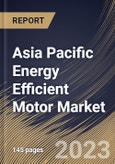Increasing automation and robotics in the manufacturing sector, surging need to reduce the greenhouse effect, rising demand from HVAC and household applications, reduction in the cost of energy consumed, rising sales of electric vehicles, and increasing support from governments for the widespread use of energy efficient motors are some of the major factors driving the growth of the market. The key market participants are spending a significant amount of money on research and development (R&D) to broaden their product offerings, which will further stimulate market expansion.
In addition, market participants are engaging in various strategic activities to grow their presence in response to key market developments such as the introduction of new products, the establishment of contractual agreements, the conclusion of mergers and acquisitions, an increase in investments, and cooperation with other organizations are all examples of recent developments. Furthermore, to flourish and prosper in a market climate that is getting more competitive and expanding, companies in the market are working hard to deliver products at low prices.
To lower environmental CO2 emission levels from businesses, enterprises, and machinery and appliances, the Ministry of Power is implementing energy-saving measures. Perform Achieve and Trade (PAT) Scheme is a crucial program for big businesses and organizations. By updating technologies or implementing internal measures to reduce energy usage, this plan seeks to increase how cost-effective energy savings are. The program sets mandated goals for the specified Large Units, and whatever excess energy they save is converted into tradable Energy Saving Certificates. Depending on the amount of energy they use and the potential for savings, many businesses and industries are given different energy efficiency targets. The government's efforts to lower energy use and various industries' carbon footprints would increase APAC's demand for energy-efficient motors.
The China market dominated the Asia Pacific Energy Efficient Motor Market by Country in 2022 and would continue to be a dominant market till 2029; thereby, achieving a market value of $7,001 Million by 2029. The Japan market is experiencing a CAGR of 7.4% during (2023-2029). Additionally, The India market would exhibit a CAGR of 8.7% during (2023-2029).
Based on Application, the market is segmented into HVAC & Pumps, Fans, Compressors, Refrigeration and Material Handling & Material Processing. Based on Efficiency Level, the market is segmented into IE3, IE2, IE1, IE4 and IE5. Based on Power Output Rating, the market is segmented into < 1KW, 1 - 2.2 KW, 2.2 - 375 KW and >375 KW. Based on Type, the market is segmented into AC Motors and DC Motors. Based on End-user, the market is segmented into Industrial, Commercial, Residential, Automotive, Agriculture and Aerospace & Defense. Based on countries, the market is segmented into China, Japan, India, South Korea, Singapore, Malaysia, and Rest of Asia Pacific.
The market research report covers the analysis of key stake holders of the market. Key companies profiled in the report include ABB Group, Siemens AG, Toshiba Corporation, Rockwell Automation, Inc., Nidec Corporation, WEG Equipamentos Eletricos SA, Mitsubishi Electric Corporation, Havells India Ltd., CG Power & Industrial Solutions Ltd. (Murugappa Group) and Kirloskar Brothers Limited (Kirloskar Group)
Scope of the Study
By Application
- HVAC & Pumps
- Fans
- Compressors
- Refrigeration
- Material Handling & Material Processing
By Efficiency Level
- IE3
- IE2
- IE1
- IE4
- IE5
By Power Output Rating
- < 1KW
- 1 - 2.2 KW
- 2 - 375 KW
- >375 KW
By Type
- AC Motors
- DC Motors
By End-user
- Industrial
- Commercial
- Residential
- Automotive
- Agriculture
- Aerospace & Defense
By Country
- China
- Japan
- India
- South Korea
- Singapore
- Malaysia
- Rest of Asia Pacific
Key Market Players
List of Companies Profiled in the Report:
- ABB Group
- Siemens AG
- Toshiba Corporation
- Rockwell Automation, Inc.
- Nidec Corporation
- WEG Equipamentos Eletricos SA
- Mitsubishi Electric Corporation
- Havells India Ltd.
- CG Power & Industrial Solutions Ltd. (Murugappa Group)
- Kirloskar Brothers Limited (Kirloskar Group)
Unique Offerings
- Exhaustive coverage
- The highest number of Market tables and figures
- Subscription-based model available
- Guaranteed best price
- Assured post sales research support with 10% customization free
Table of Contents
Companies Mentioned
- ABB Group
- Siemens AG
- Toshiba Corporation
- Rockwell Automation, Inc.
- Nidec Corporation
- WEG Equipamentos Eletricos SA
- Mitsubishi Electric Corporation
- Havells India Ltd.
- CG Power & Industrial Solutions Ltd. (Murugappa Group)
- Kirloskar Brothers Limited (Kirloskar Group)
Methodology

LOADING...








